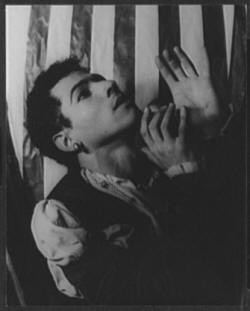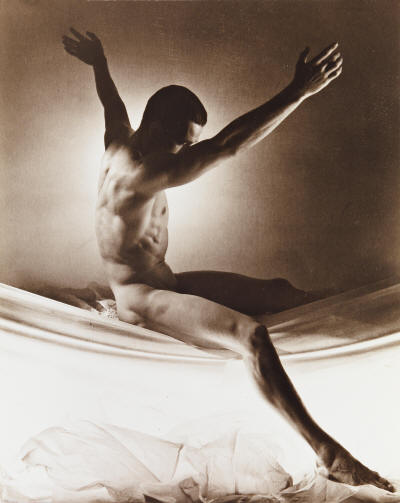

 Francisco
“Frank” Moncion (July 6, 1918 – April 1, 1995) was a charter member of the New York City Ballet. Moncion said that as a young teenager he was walking down the street minding his own business when
Lincoln Kirstein passed by and shouted, “Hey, kid, want to be a dancer?” Kirstein undoubtedly had an eye for talent, for Moncion was also to become an important lead dancer with the company. Over the course of his long career, spanning some forty years, he created roles in major works by
George Balanchine,
Jerome Robbins, and others. He was also a choreographer himself and a talented amateur painter.[1]
Francisco
“Frank” Moncion (July 6, 1918 – April 1, 1995) was a charter member of the New York City Ballet. Moncion said that as a young teenager he was walking down the street minding his own business when
Lincoln Kirstein passed by and shouted, “Hey, kid, want to be a dancer?” Kirstein undoubtedly had an eye for talent, for Moncion was also to become an important lead dancer with the company. Over the course of his long career, spanning some forty years, he created roles in major works by
George Balanchine,
Jerome Robbins, and others. He was also a choreographer himself and a talented amateur painter.[1]
Francisco Monción was born in Concepción de la Vega, a large city in La Vega province in the center of the Dominican Republic. His family immigrated to the United States in 1922 or 1923, when he was four years old. Moncion's surname is well known in the Dominican Republic, as his family is connected to General Benito Monción (1826–1898), an army officer of French descent who fought in the Dominican Restoration War. In 1947, Francisco Moncion became a citizen of the United States.
He did not begin dance training until he was twenty, and then it was almost by accident. In 1938, he was offered a scholarship to the recently established School of American Ballet, then engaged in recruiting male students. He accepted the offer and soon found himself in technique classes with Balanchine, Pierre Vladimiroff, and Anatole Oboukoff, undergoing the strict discipline of the Russian school of classical ballet. In 1942, while still a student, he appeared in the ensemble of Balanchine's Ballet Imperial in a production by the New Opera Company at the Majestic Theater in New York. However, as World War II was raging in Europe, he postponed his thoughts of becoming a professional dancer and enlisted in the U.S. Army. After two years of military service, he was discharged, whereupon he returned to New York and began his theatrical career.[2]

GEORGE PLATT LYNES (1907-1955)
Francisco Moncion.
Silver print, the image measuring 241.3x190.5 mm; 9 1/2x7 1/2 inches, with the subject's name and date, in pencil, and Lynes' credit hand stamp, on verso. 1951.
Moncion's first engagement as a professional dancer was as a "gypsy" in a Broadway revival of The Merry Widow, Franz Lehár's famous operetta, with dances choreographed by Balanchine. When this show closed, in May 1944, he joined the marquis de Cuevas's Ballet International as a principal, creating the title roles in two major productions later that year: Edward Caton's Sebastian and Léonide Massine's Mad Tristan, a Surrealist work with spectacular designs by Salvador Dalí. Of the latter, Edwin Denby wrote, "Besides Dalí, there was one other hero Friday night, Francisco Moncion, who took the part of Tristan. He carried off the most acrobatically strenuous part without a flaw, and more than that he projected the character and the story convincingly. He is a very fine dancer indeed, and a quite exceptionally imaginative one.[3] Following this engagement, Moncion performed briefly with Colonel de Basil's Original Ballet Russe during the early months of the 1946/47 season. He then became an original member of Ballet Society, formed by Balanchine and Lincoln Kirstein in 1947, and later of its successor, the New York City Ballet. During the four decades that he spent in these companies, he created a number of important roles and participated in many historic performances. At the first performance of the New York City Ballet on October 11, 1948, he danced in all three ballets on the program: Concerto Barocco, Orpheus, and Symphony in C.[4] Decades later, during the troupe's 20th anniversary season he appeared in the premier of Jacques d'Amboise's Tchaikovsky Suite No. 2 in collaboration with Robert Irving and John Serry Sr.[5][6][7][8]
Early in his career, it became clear that Moncion would never be a true danseur noble. He lacked the elegance of bearing and refinement required for princely roles. Yet it was equally clear that he was capable of effective portrayals in many different roles as a premier danseur. He was a dashing figure in the Balanchine dances for the Broadway production of The Chocolate Soldier (1947), swirling and twirling with Mary Ellen Moylan. He was a delicately tender partner to Tanaquil Le Clercq in Jerome Robbins's meditative Afternoon of a Faun (1953), bringing a sensual, feline languor to the part. He was dramatically powerful in the title role of Balanchine's Prodigal Son, entranced by the Siren of Yvonne Mounsey and then heartbreakingly contrite as he painfully made his way home to his father. In stark contrast, he was hilariously funny as The Husband in Robbins's The Concert, smoking his cigar and flitting about the stage to butterfly music. And, of course, he was mysteriously compelling and beautiful in Orpheus, as the brooding Dark Angel, the role for which he is perhaps best remembered.[11]
In the 1950s and 1960s, Moncion experimented with choreographing works of his own. He made four for the New York City Ballet and two for other companies.[12]
After his retirement from the stage in 1983, Moncion spent his leisure years at his home in Woodstock, New York, indulging his considerable talent for oil painting. His works were shown in several New York exhibitions. He died of cancer at his home at the age of 76.[13]
My published books: